
‘Fog Cutter’ takes top team award in Venice marlin tournament.
The cocaho, variously spelled cocahoe, cacaho or cacahoe in Louisiana, is known by anglers as the mud minnow in Texas and the bull minnow in Alabama and Florida. Officially, it is the gulf killifish. Unofficially, it is bait wherever speckled trout and redfish fishermen are found.
The biggest advantage that cocahoes have as live bait, says Sid Bourgeois, is that they are more durable and last longer in the livewell and on the hook.
“They can stand a bite or two,” he said.
Another big advantage is availability. Unlike other live baits, they can be purchased 12 months a year. Shrimp have legal and natural seasons. Croakers are only available when shrimp season is open as they are trawl-caught. Pogies are too small or too large for use as bait much of the year.
Cocahoes work best in interior lakes and bays, near their natural marsh habitat.
“You are going to catch the devil to find cocahoes in the Gulf,” says Bourgeois.
“You gotta match the hatch,” adds Bonano.
Bourgeois expresses a preference for medium-sized cocahoes, but added that he has several regular customers at Joe’s Landing who praise little ones.
“I don’t know why, but I’m glad,” he laughs heartily, “since we have a lot of people who always want big ones.”
“That’s me. I want big ones,” pipes in Bonano.
Bourgeois throws his partner a glance and says for his benefit, “It’s hard; we really can’t let customers sort them.”
Bonano is careful how he puts his cocahoes on the hook, always running the hook through the bottom jaw first and then through the upper jaw. This keeps the point of the hook up and away from bottom debris. He also feels that the minnows swim more naturally that way.
Bourgeois, on the other hand, hooks them bottom-up or top-down — “whatever way I grab them.”
As a final note on cocahoes, Bourgeois notes that they will sometimes, usually during periods of extreme high tides during storm season, be able to purchase storm minnows for bait. Although, with their stumpy body shape they resemble cocahoes, they are an entirely different species, properly called fat sleepers, and in an entirely different family.
Storm minnows have a near-legendary reputation among some anglers as a trout and redfish bait. The major difference that Bourgeois sees is that they are incredibly tough.
“You can catch five fish on one storm minnow,” he said.
He tells a story about a bait fisherman who brought a plastic basket of them from St. Bernard Parish to Joe’s Landing (at least a two-hour journey) covered only with a wet burlap sack.
“Every one of them lived,” he says in amazement.
Storm minnows sell for the same price as cocahoes when he has them.
Editor’s note: This article is part of the Live bait Barataria feature in the July issue of Louisiana Sportsman, which is now on newsstands. Digital editions also can be downloaded right to your computer or smartphone.
Be sure to subscribe to ensure you don’t miss a single information-packed issue of Louisiana Sportsman.


